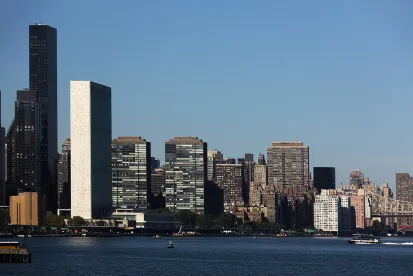Originally signed into law on May 5, 2021, in response to the COVID-19 crisis, the New York Health and Essential Rights Act (NY HERO Act or Act) requires almost all private New York employers to adopt workplace health and safety measures to protect employees against exposure and infection during a declared airborne disease outbreak. The Act was triggered on September 6, 2021, when Governor Kathy Hochul declared COVID-19 an airborne infectious disease. Two weeks later, on September 23, 2021, the New York Department of Labor (DOL) issued updated model plans.
Employers who have not yet implemented a plan as required by the Act in May need to do so now, and those who met the initial deadlines should review their plans to ensure they comport with the new model plans.
Covered Employers
The Act covers almost all private employers with employees in New York, unless the employees or employers fall within the temporary or permanent OSHA standard on COVID-19 or other designated airborne infectious disease – currently only the health care industry – and specifically includes employers based outside of New York with employees based or working within New York.
Definition of a Worksite
A “worksite” is defined as any physical, designated space where work is performed and over which the employer has the ability to exercise control – including employer-provided housing and transportation. Nontraditional workplaces (i.e., private households and employees working for digital applications or platforms) are covered; however, the NY HERO Act does not cover telework or any worksite that the employer does not have the ability to control.
Employer Obligations
The NY HERO Act established the Airborne Infectious Disease Exposure Prevention Standard (Standard), which requires employers to provide a workplace safety plan in writing to all workers within 30 days of adoption of the DOL’s published model standards (July 6, 2021); within 15 days of reopening due to airborne infectious disease–related closure; and to all new workers upon hiring.
In addition to circulating the workplace safety plan in writing, employers must post the written plan in a prominent, visible location at each worksite and provide a verbal review of the plan to all employees. The verbal review need not be in person; employers are encouraged to explore the most suitable manner of disseminating the information – including audio/video technology and videoconferencing technology.
The Act provides notable exceptions to the employer’s verbal review requirement for its workers who are individuals working for staffing agencies, contractors and subcontractors, or individuals delivering goods or transporting people to/from the worksite.
Model Plans
The New York DOL and New York Department of Health (DOH) collaborated to develop a general model plan, the Model Airborne Infectious Disease Exposure Prevention Plan, and 11 industry-specific model plans for employers to adopt. Employers have the option of choosing one of the DOL’s templates or establishing their own custom plan that meets or exceeds the NY HERO Act’s minimum requirements.
The 11 industry-specific templates created by DOL and DOH include: Agriculture, Construction, Vehicle Operations for Delivery Services, Domestic Workers; Emergency Response, Food Service, Manufacturing and Industrial, Personal Services, Private Education, Private Transportation by Automobile and Retail.
In addition to the general model plan, each of the above-referenced industries has a unique template with “Advanced Controls” sections tailored specifically to that industry. These industry-specific templates can be accessed on the DOL website.
Notably, should an employer choose to create their own airborne infectious disease plan, or significantly modify a DOL template, the employer must engage employees and provide them with the opportunity to review and/or participate in the creation of the plan.
The DOL’s September 23, 2021, updated plans incorporate more recent indoor mask guidelines. As a result, any employer who adopted a plan prior to the most recent model plan should review and revise their plan as necessary either by adopting the revised model plan appropriate to their industry or by providing employees with the opportunity to review and/or participate in the creation of the plan.
Employee Participation
Section 2 of the NY HERO Act requires employers with 10 or more employees to establish a Joint Labor-Management Workplace Safety Committee (Committee). The objective of this Committee is to ensure that workers have an integral role in worksite safety and have an avenue to raise safety and health concerns directly with management.
The Act requires that Committees must be composed of employee and employer representatives, with all members being selected by non-supervisory employees, and at least two thirds of the total members must be non-supervisory employees. The Committee must be co-chaired by one representative each of the employer and of the non-supervisory employees. Where there is a collective bargaining agreement (CBA) in place, the CBA is responsible for the selection of the Committee members.
The Act authorizes the Committee to review workplace policies relating to occupational safety and health and encourages all employers to engage their workforce on the adoption and implementation of such plans; however, if an employer adopts one of the DOL plans or templates, it is not required to have employees review and give feedback before adoption. Employer modifications to the “Controls” or “Advanced Controls” sections of the DOL templates do not necessarily constitute an “alternative plan,” unless the alterations are extensive, thereby triggering the requirement for employee participation.
The Act also includes antidiscrimination and anti-retaliation protections prohibiting employers from taking adverse actions against workers for exercising their rights and engaging in protected activities under the Act, including:
-
Following the requirements of the employer’s plan
-
Reporting concerns on the implementation of a plan
-
Reporting violations of the adopted plan
-
Refusing to work based on a good faith belief that workers are placed at an unreasonable risk of exposure due to working conditions that are inconsistent with the Act or other workplace safety laws.
The deadline to establish a Joint Labor-Management Workplace Safety Committee is November 1, 2021.
Beyond COVID-19
The Act applies to more than COVID-19. In addition to the above standing requirements, employers must take the following steps when the New York State Commissioner of Health classifies a new disease as a highly contagious, communicable airborne disease:
-
Immediately review their worksites’ exposure prevention plan and update the plan as necessary to fully incorporate any new information, guidance and mandatory requirements issued by federal, state and/or local government agencies related to the specific infectious agent of concern.
-
Finalize and promptly activate the updated worksite exposure and prevention plan.
-
Provide a verbal review of the updated plan to their employees.
-
Provide each employee with a written copy of the updated plan (in English or the employee’s primary language), and post the plan at all worksites in a manner making it accessible to workers during all work shifts.
COVID-19 Delta Variant Implications
On September 6, 2021, Governor Hochul officially declared COVID-19 an airborne infectious disease under the NY HERO Act. To the extent an employer has not already done so, this official designation triggers the employer’s responsibility to immediately follow the above steps in an effort to prevent the spread of the COVID-19 Delta variant.
Enforcement
Employers may be subject to daily penalties between $50.00 and $10,000.00 for failure to comply with the NY HERO Act requirements.



 />i
/>i
